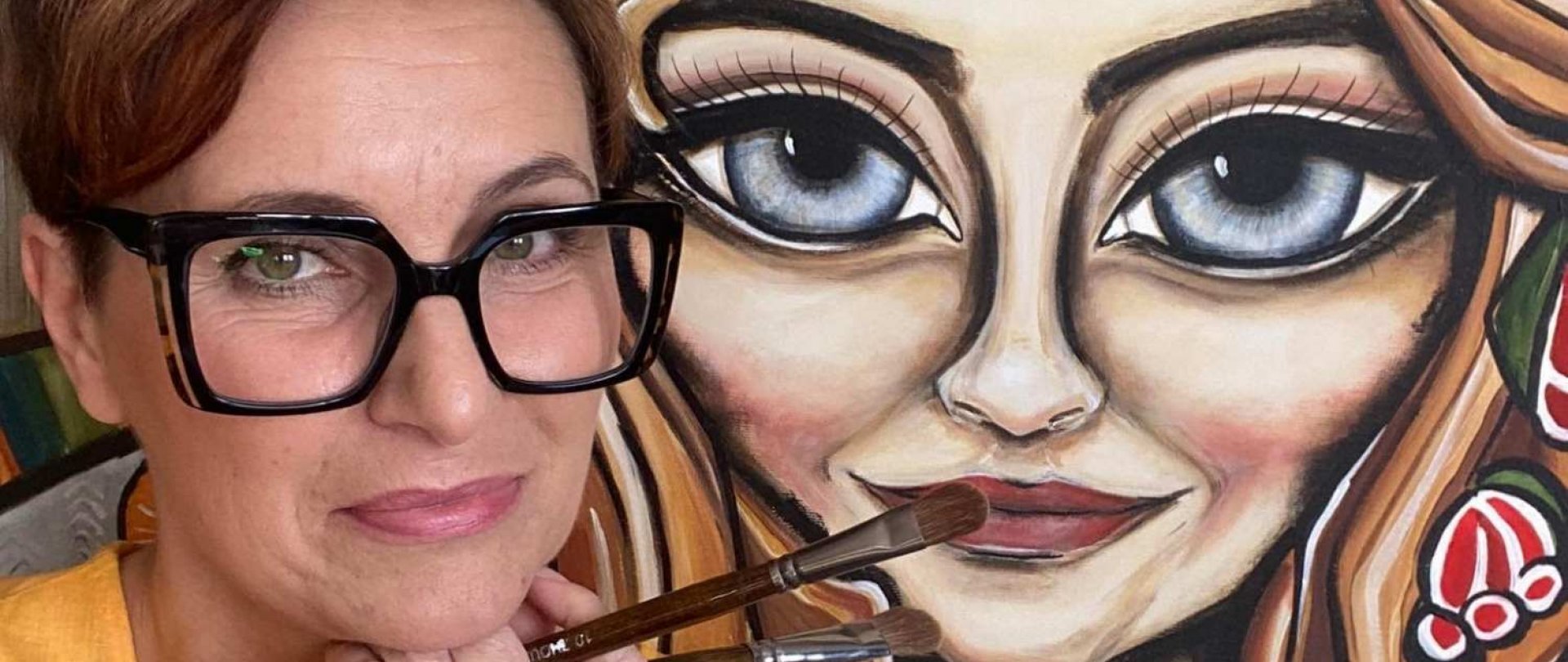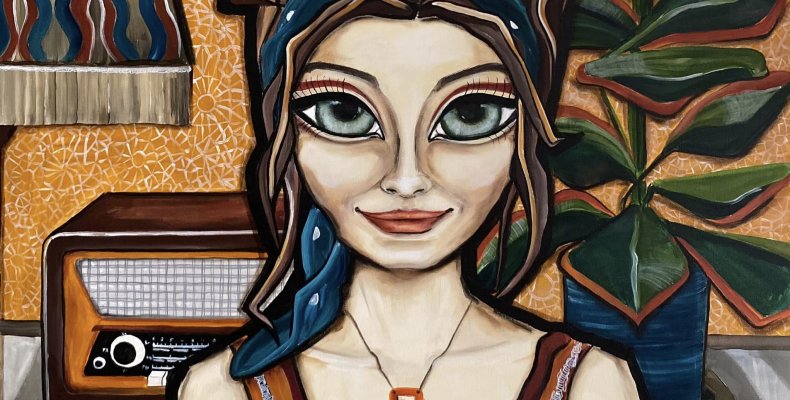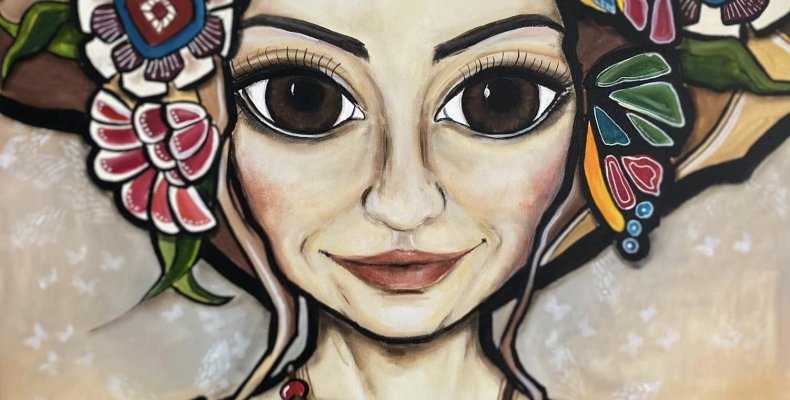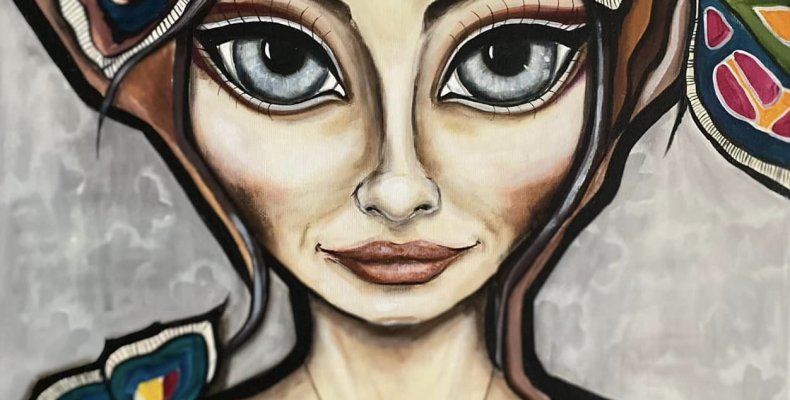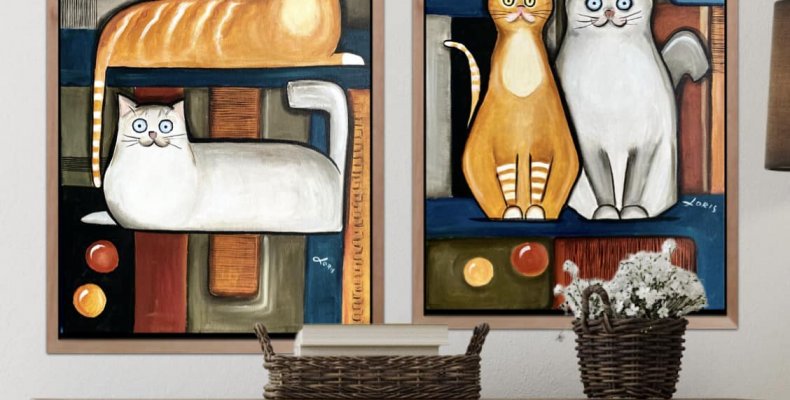"Fall" is a word that perfectly describes the story of Agnieszka Lorek's artistic journey with its blunt sound. Sometimes, to discover your true nature, you need a strong push from life. That was the case with her. Today, we can admire her paintings at the Vestina Hotel in Wisła.
We discuss the first steps in the world of painting with this self-taught artist, whose paintings, featuring the characteristic large eyes, have gained recognition and popularity in online art groups. You can see her artwork live at the Opus Unicus Gallery, the Black Art Auction House, and, of course, at the Vestina Hotel in Wisła.
You have only recently started painting, and the beginnings of your passion were quite unusual and unpleasant. Could you tell us how it all began?
Agnieszka Lorek: Art has always been with me, but it was only recently, at the end of 2020, that I started painting as part of art therapy. My life took such a turn that I had never had the opportunity to try myself as an artist before. I had always been an office worker, working in debt collection for a bailiff, and then many years in HR, dealing with vocational rehabilitation for people with disabilities, recruitment, and training. All my jobs were emotionally draining, so I turned to physical activity as a way to unwind. A day without a 10 km run was a wasted day, and to balance it out, I did yoga. I enjoyed pushing myself physically, sweating, and feeling my pulse racing through my body. I would call it an addiction to endorphins and dopamine, a constant rhythm of life that I had known and practiced for years.
However, as life often goes, change is the only constant. A fall from a small ladder step made a significant impact. I came back from vacation, started a new job with a heavy workload, but despite the intense period at work, which was also stressful, I decided to repaint my kitchen, dining room, and hallway. I had to deal with emotional tension in the only way I knew how, through physical exertion. I began scraping walls, moving furniture, and wrestling with kitchen cabinets. Of course, all by myself, because I, the hero, don't need to ask for help; I can handle everything on my own. It didn't matter that sometimes I fell flat on my face and couldn't muster the strength to get up; after all, I was brave and capable of doing everything. And at the end of this project, probably out of sheer exhaustion, while climbing down from a ladder step, my foot slipped on spilled paint, and I twisted my knee. The me from back then, showing no mercy to herself, loaded up on painkillers and finished the renovation. However, the condition of my knee worsened: it swelled so much that it didn't fit in my pants, and it was difficult to drive to work with my leg not bending properly. I started seeking medical help. The first specialist, after an MRI, told me that my meniscus was crushed, and the cartilage didn't look good – surgery was needed. However, I didn't share his opinion, so I went to another specialist who suggested trying plasma therapy and hyaluronic acids. But that didn't help at all, and I was still limping. I decided to have surgery. Unfortunately, it turned out that the changes were so significant that despite being able to walk normally, there was absolutely no chance of returning to my previous activities.
The lack of exercise, or in other words, the absence of endorphins, slowly but systematically led to a decrease in mood. Insomnia appeared, along with concentration problems. I couldn't and didn't want to find anything to replace it. I held on to the thought of returning to my activities so tightly that during the lockdown, driven by a crazy, imaginary idea, I bought a treadmill. I kept hoping that some miracle would happen. And a miracle did happen, but a completely different one.
The fact that the treadmill remained unused caused even greater sadness and a slow descent into depression. To avoid succumbing to it, I decided to renovate the living room because I couldn't just sit idly by. I had to do something, and since I was stuck at home, I wanted it to look nice. As usual, I scraped, painted, and wallpapered.
I wanted to hang some Ikea posters on the walls, but it turned out that the store was closed. However, I couldn't wait, and there were already nails sticking out of the walls for the pictures. I dug out some old dried-up paints and smeared something on the walls, put those posters in frames, and hung them up. My close friends came to see the room after the renovation, and they were surprised and said it was good and that I should show it to the world. I put them up for sale on a marketplace and sold them within one day, then another and another. Another significant step was participating in "Culture in Quarantine." In three days, my big-eyed girl, who is angry at the whole world, received over 1200 likes and comments, as well as many offers to buy.
My son created a Facebook profile for me, and I continued to paint. Over time, I started to develop, and I could afford professional paints, canvases, and easels. I couldn't stop; it provided me with a tremendous release of emotions. All my anger, feelings of injustice, ended up on the canvas. The colors screamed, the eyes were frightening. Every day, I was surprised at where it all came from, how I could do it. I still can't find a clear answer. In summary, the discovery of my painting talent was influenced by a fall from a ladder, the pandemic, and depression. So, three very negative events.
Looking at your first paintings and comparing them to the current ones, it's clear that the main theme hasn't changed, but progress is very visible.
Agnieszka Lorek: Painting gives me solace and a break from the prose of life. All the paintings have one constant element: the eyes in which I lock my emotions. Starting from pain, fear, sadness, to strength and shards of joy.
Recently, I have been showing my paintings on the internet more boldly. It's very gratifying when people whose artistic works I admire respond with positive comments. A highly talented painter and, for me, a contemporary icon of surrealism, Małgorzata Bańkowska, wrote under one of my paintings that she sees my progress and can't keep up with my development – that warms my heart. Some time ago, the Black Art Auction House approached me with a proposal to exhibit some of my works. The Opus Unicus Gallery sold one of my paintings to California. In such moments, I feel happiness and pride. I am also very excited about my collaboration with the Vestina Hotel.
So far, I haven't put any effort into promoting my work. Everything is happening on its own, and I am still overwhelmed that people like my paintings and that they are appreciated by professionals. The discovery of my talent also inspired my close friend to start painting. She creates beautiful paintings as Art Karla Kraft.
The dominant element of your works is the eyes. Where does this fascination come from? And how would you describe your style?
Agnieszka Lorek: I have always liked eyes. When I look at paintings and photos, I focus on the eyes. They are the mirror of the soul, and everything is in them. Through the eyes, we manifest our soul, emotions, and mood. Behind every new painting is a human story. As for the colors on my canvases, they are simply the colors I like. Someone once ventured to evaluate my style and called it ethnic-folk with elements of pop art. It's a modern version of folk art.
However, I don't only paint girls with big eyes. I am still discovering myself. The "Stallion's Den" is a big hit. Something I created somewhat accidentally. After removing the television from the wall, there was a gap. To fill it, I painted friendly deer, which won the hearts of many. For me, it was a very short, joyful creative process. I painted them for a few hours, while large paintings usually take me 4 days. Another double portrait featuring Nikita and Stanisław, my cats, is also very popular.
Every painting is filled with emotions, and after finishing one, I give myself a day off. I can't immediately move on to painting another because I feel like I would transfer those emotions from the first one to the second. Painting is a continuous process – I think about it at the canvas, when I wake up in the morning, when I fall asleep. I need to take a longer break afterward to create something new.
What are your plans and dreams? What does the future hold?
Agnieszka Lorek: Only now in my life am I at a point where I'm not afraid to dream. Paintings evoke emotions, they don't go unnoticed; they mean something. I want to have a beautiful Gallery at the Vestina Hotel to please the eye of the guests, and perhaps other hotels will be interested in my work. I would like my paintings to find a place in Polish galleries in Pomerania and, of course, in other parts of Europe.
We invite you to visit the artist's website, where you can explore her work in more detail.


